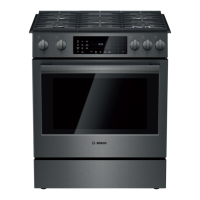Cooktop operation en-us
27
¡ Foods that must be kept moist should be covered with a
lid or aluminum foil.
¡ Aluminum foil may be used to cover food. Use only
heat-safe dishes.
¡ DO NOT open the oven door unnecessarily. Opening
the door will reduce the temperature of the oven.
¡ When keeping cooked food warm, allow time for the
oven to preheat before placing the item in the oven.
7.12 Getting the best results
¡ Minimize opening the oven door.
¡ Use the rack position recommended by the recipe.
¡ Use the bakeware recommended in the recipe.
¡ Store pans outside the oven. An extra pan without food
affects the browning and cooking.
¡ The type of pan used affects the browning.
– For tender, golden brown crusts, use light non-stick/
anodized or shiny metal pans.
– For brown crisp crusts, use dark non-stick, anodized
or dark, dull metal pans or glass bakeware. These
may require lowering the bake temperature 25°F.
Preheating the oven
¡ Most cooking times in recipes are designed for a
preheated oven and require that the oven already be at
a certain temperature before cooking starts. Refer to
your recipe for preheating recommendations.
¡ Preheating time depends on the temperature setting
and the number of racks in the oven. Remove unused
oven racks to shorten the preheat time.
¡ Preheating is not necessary for Roast and Conv
Roast.
Bakeware type
¡ Metal bakeware with or without a non-stick finish, heat-
proof glass, glass-ceramic, pottery, or other utensils are
suitable for the oven.
¡ Suitable cookie sheets have a small lip on one side.
Heavy sheets or those with more than one side may
affect the baking time.
Pan placement
¡ Allow at least 1'' (2.5cm) of space between the pans
and the oven walls so heat can circulate around each
pan.
¡ Stagger bakeware so that one is not directly above
another. Allow 1½'' (4cm) above and below each pan.
High altitude baking
When cooking at high altitudes, recipes and cooking times
will vary. For accurate information, go to
www.csuextstore.com, or write to the Extension Service,
Colorado State University, Fort Collins, Colorado 80521.
There may be a cost for the guides. Specify which high
altitude food preparation guide you prefer: general
information, cakes, cookies, breads, etc.
Condensation
It is normal for a certain amount of moisture to evaporate
from the food during any cooking process. The amount
depends on the moisture content of the food. The moisture
will condense on any surface cooler than the inside of the
oven, such as the control panel.
Cooktop operation
8 Cooktop operation
Cooktop operation
Here you will find out everything you need to know about
operating your cooktop.
8.1 Cookware
This information will help you save energy and avoid
damaging your cookware.
Using cookware
The selection and positioning of the cookware affects the
safety and energy efficiency of your appliance.
Ensure that the size of the cookware is
suitable for the burner size. Never use
small cookware on large burners.
Ensure that the flame does not touch
the sides of the cookware.
Do not use deformed cookware.
Deformed cookware is not stable on
the cooktop and may tip over. Use
cookware with a thick, flat base.
Do not cook without a lid. Ensure that
the lid does not move. When cooking
without a lid, a large amount of the
energy will escape.
Position the cookware in the middle of
the burner, otherwise it may tip over.
Do not position large cookware on the
burners close to the controls. The
controls may be damaged due to
overheating.
Place the cookware on the burner
grates. Never place the cookware
directly on the burner. Before using the
appliance, ensure that the burner
grates and the burner caps are
positioned correctly.
Handle the cookware that is on the
cooktop carefully. Do not bang on the
cooktop. Do not place heavy weights
on the cooktop.
Never use multiple burners to heat up
cookware, such as roaster, pan, grill
stone. The build-up of heat that results
from this will damage the appliance.

